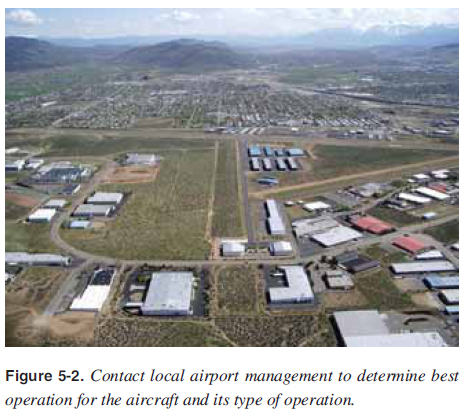
 |
|
||
| CHAPTER 5. Prefl ight and Ground Operations
Where To Fly The weight-shift control (WSC) aircraft can be transported by trailer from one fl ying fi eld to the next. For as many benefi ts as this provides, transporting the aircraft into unfamiliar territory also includes some safety and operational issues. Contact airport management to inquire about any special arrangements to be made prior to arriving by trailer [Figure 5-1] and there may be special considerations for fl ying WSC aircraft with other aircraft. With smaller patterns typically used by WSC aircraft, as covered in Chapter 10, Airport Traffi c Patterns, airport management may want a pilot to operate over sparsely populated areas rather than the normal airplane patterns over congested areas because of the unique noise of the WSC aircraft. [Figure 5-2] Check the Airport/Facility Directory (A/FD) all required airport information per Title 14 of the Code of federal Regulations (14 CFR) part 91 section 103, Prefl ight information. Some operation examples are traffi c pattern information, noise abatement procedures , no fl y zones surrounding the airport, and special accommodations that may need to be arranged for WSC aircraft..   Because of the wide range of flying characteristics of the WSC aircraft, inform local pilots about some of the incidentals of the specifi c WSC aircraft (e.g., fl ying low and slow for certain confi gurations). The more non-WSC aircraft pilots know about WSC fl ight characteristics and intentions, the better they understand how to cooperate in fl ight. Sharing the same airspace with various aircraft categories requires pilots to know and understand the rules and understand the fl ight characteristics and performance limitations of the different aircraft. For operations at nonaircraft fi elds, special considerations must be evaluated. Permission is necessary to use private property as an airstrip. Locate the area on an aeronautical sectional chart to check for possible airspace violations or unusual hazards that could arise by not knowing the terrain or location. Avoid loitering around residential structures and animal enclosures because of the slow fl ight characteristics of WSC aircraft and distinct engine noise. While selecting a takeoff position, make certain the approach and takeoff paths are clear of other aircraft. Fences, power lines, trees, buildings, and other obstacles should not be in the immediate fl ightpath unless the pilot is certain he or she is able to safely clear them during takeoff and landing operations. Walk the entire length of the intended takeoff and landing area prior to departure. [Figure 5-3] Look for holes, muddy spots, rocks, dips in the terrain, high grass, and other objects that can cause problems during takeoff and landing. Physically mark areas of concern with paint, fl ags, or cones. Uneven ground, mud, potholes, or items in fi elds such as rocks might not be visible from the air. Plowed rows and vegetation are larger than they appear from the air. Unfamiliar fi elds can make suitable landing areas for emergencies, but should not be used as intended landing areas. Extreme caution must be exercised when operating from a new fi eld or area for the fi rst time.  |
| ŠAvStop Online Magazine Contact Us Return To Books |